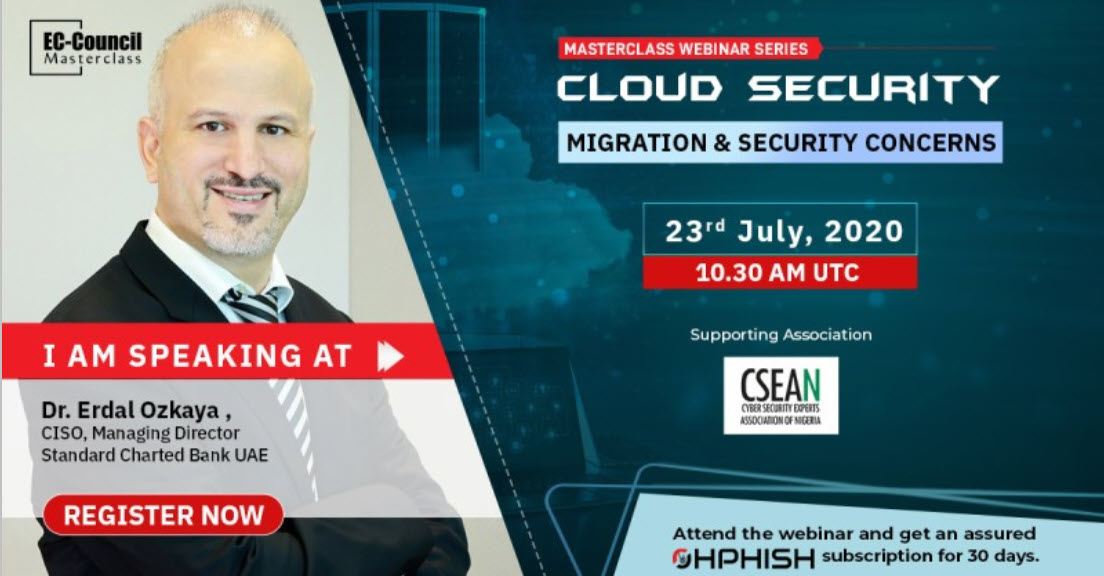
EC Council Master Class Event 2020
EC Council Master Class Event Cloud Security – Migration & Security Concerns
EC Council is hosting a Cloud Security summit , were I will be also a speaker. If you want all about Cloud Security and concerns please feel free to join us.
When: Thu, Jul 23, 2020
Time : 8:30 PM – 10:30 PM AEST
Registration : https://register.gotowebinar.com/register/5684806476690816016

About EC-Council:
EC-Council’s sole purpose is to build and refine the cybersecurity profession globally. We help individuals, organizations, educators, and governments address global workforce problems through the development and curation of world-class cybersecurity education programs and their corresponding certifications and provide cybersecurity services to some of the largest businesses globally.
Natcha Bakir, the Department of Defense, Intelligence Community, NATO, and over 2,000 of the best Universities, Colleges, and Training Companies, our programs have proliferated through over 140 Countries and have set the bar in cybersecurity education. Best known for the Certified Ethical Hacker program, we are dedicated to equipping over 230,000 information age soldiers with the knowledge, skills, and abilities required to fight and win against the black hat adversaries.
EC-Council is an ANSI 17024 accredited organization and has earned recognition by the DoD under Directive 8140/8570, in the U.K. by the GCHQ, and a variety of other authoritative bodies that influence the entire profession. Founded in 2001, EC-Council employs over 400 people worldwide with 10 global offices in the USA, Canada, U.K., Malaysia, Singapore, India, and Indonesia.
About CISO Mag
CISO MAG is the cyber security news publication for every stakeholder of safe Internet. If you are looking to keep abreast of the latest happenings in information security and are curious to know how security leaders are battling out of their skins to keep Internet safe, we assure you that you won’t be disappointed.
Why we do what we do?
Well, the threats we foresee in cyber world are not expected to cease and one can only expect to uncover more calculated attacks on a wider scale. Therefore, there is a continuous need to provide unbiased and useful information to the professionals working in this critical sector. To provide the cybersecurity experts key information and analysis to tackle the security challenges, EC-Council created CISO MAG, an information security magazine for best practices, trends, and news.
We are a passionate bunch of people who love to give voice to information. We research intense, write with credibility and bring to you the information every security leader needs to know.
And we don’t want you to just believe it because we say it, we want you to discover it yourself. Check out our magazine that has already reached 50,000+ readers globally within its first year of launch.
To know more about the magazine , click here
Cloud Security
By Guest Author : Ahmed Nabil
Nowadays everyone is talking about the cloud and the benefits of moving your environment, infrastructure, platforms to the cloud which is true from my point of view. Take the current pandemic situation of Corona virus and the mandate of remote working or working from home model. Now imagine the ease of this model if your environment is on the cloud or your are leveraging tools and technologies running on the cloud allowing you to connect from anywhere to work and deliver as if you are in your traditional office.
What is cloud computing?
According to NIST 800-145 definition, the cloud main characteristics is being on demand service, broad network access, resource pooling, rapid elasticity and measured service. Does this definition help us as security professionals? As you can see the driving factor for cloud was mainly productivity, availability and resiliency which is perfectly fine, but the security is missed in this equation.
The problem is once you move to the cloud and start consuming services, it become an endless project. The migration or extension to cloud services will add more tools, computers, servers, applications to your current IT portfolio. In other words, a totally new open surface of attack or a new network perimeter that you need to secure.
Introducing the cloud to your current IT environment will add more challenges to your environment as follows:
- Integrations of new applications and existing ones (which maybe be obsolete or in-house developed).
- Manageability of assets on-premise and in the cloud
- Data flowing between your on-premise environment and cloud devices and applications. Remember the new privacy and information regulations as GDPR.
- Different silos of process and tools
This is a complete transformation and on top of it, security is shaped to tackle all these challenges.
Information Security Transformation
Most of the businesses are transforming to the new digital by using the latest technologies. One of the main reasons of this transformation is to compete with digital native startups. New digital startups are disrupting the business and forcing their competitors either to move to new digital business or simply exit the market.
This new IT and digital world will provide both challenges and opportunities for information security. While the challenges are significant as we discussed earlier, there is also a huge opportunity to solve longstanding security problems using the new technology and platforms and on top of them is the cloud.
It’s very clear now with the above-mentioned challenges that the old network perimeter is changing. Back in the old days your perimeter was your office network, you need to check in your office and connect to the network to start accessing and working on your data and files. Now with cloud the network perimeter dissolved. Users can access and work from anywhere on almost any device and platform.
This new modern perimeter is the identity perimeter which means the main protection is the identity controls used to protect your data (Information assets) and your end point devices. This requires a new architecture mindset based on the famous cloud/customer cloud responsibility matrix.
Cloud and Customer responsibility sharing
Some users think that moving to the cloud will make them more secure by default while others think they are even more vulnerable and the truth it’s a shared responsibility between both parties. Cloud will definitely offer better security options but again the user must use it and sometimes configure it to get the best out of the cloud.
Let us take the Software as a Service example (SAAS) which is one of the most common models of leveraging the cloud. According the below Cloud/Customers responsibility matrix, three main areas for customer responsibility are as follows:
- Identity Protection
- Information protection
- Endpoint protection
Identity Protection which is very crucial means more investment in Privilege Access Management software, getting rid of old legacy identities, adopting IAM solutions that support single sign-on (SSO) and leverages protocols like (SAML) to integrate with third parties and other partners, use of Multi-factor authentication since password alone will not be sufficient anymore to protect your account and finally quality monitoring of all connections and authentications to your system with proper alerting system.
Endpoint Protection which requires cross platform management solution to manage any client on any platform, sound endpoint protection solution with endpoint detection and response capabilities (EDR), device compliance solution to ensure all connected devices are healthy and again on top of these your monitoring solution.
Information Protection which is the most critical moving part and the responsibility falls on the customer only as the sole owner of these information. Adapting a cross platform solution to scan your resources, classify, label data/files, protect them (encryption for example) and then monitoring the usage of this information on any platform.
As you can see with the SAAS model, the customer side should take care of key areas and rely on the cloud service provider on other areas as hardware, datacenter, applications, patching and maintenance. This is the real benefit of cloud.
Conclusion
Cloud is real opportunity but a challenge for us as security professionals. It’s not just someone else computer accessed remotely but rather a new mind shift with new process, technologies, tools and more importantly operations. It cannot be treated as traditional IT environment otherwise we will not only miss the cloud benefits but might be open for more different threat vectors.
To see my other awards :
https://www.erdalozkaya.com/category/about-erdal-ozkaya/awards/
EC Council CEH Hall of Fame 2021 – Hall of Fame





